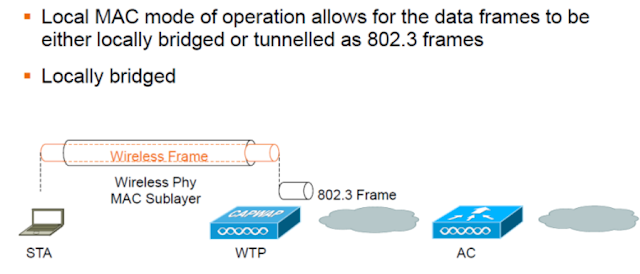Wireless wlc and access point
Wireless wlc and access point -
Wireless Standards --
IEEE 802.11 set of standards defines Layer 1 and Layer 2 operations of wireless networks. The latest standard that Cisco Access Points support at the time of writing is 802.11ax (Wi-Fi 6)
IETF’s RFC 5415 standardizes communication protocol between a WLC and an Access Point – Control And Provisioning of Wireless Access Points (CAPWAP)
What is Access Points (APs) -
Wireless clients connect to an Access Point to communicate with each other and with the devices on the wired network that the AP is connected to. Single Access Point forms a BSS (Basic Service Set), which is identified by its MAC address
Access Point advertises one or many wireless networks identified by an SSID (Service Set ID). A WLAN can be mapped to a VLAN on the wired side of an access point
What is Autonomous vs Lightweight APs --
Access Point’s mode of operations can be either Autonomous or Controller-based -
The management plane deals with the static configuration of Access Points. APs in autonomous mode can be managed directly via Web interface or CLI. In contrast, controller-based APs don’t allow direct configuration changes and, instead, are managed by the controller
The controller is not always a dedicated physical or virtual appliance, it can also be cloud-based service (Meraki)
Control Plane --
The control plane is responsible for dynamic access point operations, such as radio parameters management and user authentication. Autonomous APs perform all these tasks on their own. Controller-based (or Lightweight) APs shift these tasks to the controller. For example, a controller can instruct access points to change a radio channel and decrease transmit power,
Data Plane -
The Data plane is responsible for moving data between wireless clients and the wired networks. An autonomous AP switches data directly to the wired network based on its SSID-to-VLAN mapping
There are below types of methods -
- Local or Split MAC mode. In this mode, all user data traffic is tunneled to WLC
- FlexConnect – central switching mode. Data plane is similar to local mode, however, some traffic can be switched locally. When the controller is not reachable, AP operates as an autonomous AP
- FlexConnect – local switching mode. Data plane is similar to autonomous AP, which switches traffic locally to wired network based on configured SSID-to-VLAN mapping using 802.1q tagging
- SD-Access mode. In this mode, AP connects to the SD-Access Edge switch and transmits data via SD-Access fabric using VXLAN encapsulation (check this link for more information on SD-Access).
What is Wireless LAN Controllers (WLCs) -
Managing a number of autonomous APs is getting more difficult as device number grows, as the configuration must be consistent across many devices
Common models of WLC below -
- WLC 3504 (AireOS)
- WLC 5520 (AireOS)
- WLC 8540 (AireOS)
- Mobility Express on APs (AireOS)
- Catalyst 9800 series (IOS-XE): 9800-L, 9800-40, 9840-80, 9800-CL (virtual)
- Embedded WLC on APs and Switches (IOS-XE)
Cisco Wireless LAN Controllers were traditionally running AireOS software. The Cisco controller-less solution with the WLC role performed by an 802.11ac Access Points is called Cisco Mobility Express
Meraki cloud-based management -
Meraki MR APs are first associated with their serial numbers with Meraki Cloud, which provides management access for the wireless LAN deployment. The AP-to-Controller communication is out-of-band and Meraki MR APs will continue to function when connectivity to Meraki Cloud is lost. During connectivity outages ability to perform configuration changes is not available
What is Split-MAC --
This type of deployment is suitable for large campuses, where sufficient infrastructure exists for the controller to be deployed locally. In this scenario, controllers are actively participating in data forwarding. Access Points establish CAPWAP tunnels to the controller. One tunnel is used for the control plane and another carries encapsulated data payload
What is FlexConnect --
The WLC and access points also support FlexConnect mode of operation. It allows Lightweight Access Point to locally switch some or all of the user traffic instead of sending it to the controller via the CAPWAP tunnel. This mode’s purpose is to decrease the amount of traffic that needs to be sent to a controller from the branch offices.
WLC appliances support 2 modes – Central Switching and Local Switching.
When WLAN is configured to use Central Switching, traffic from an AP is still tunneled to WLC, however, local-site traffic can be enabled for local switching by configuring Split Tunneling.
AP in FlexConnect Local Switching mode switches all traffic locally, even when AP can reach WLC. It is similar to the operation of autonomous APs which also switches traffic locally by mapping SSIDs to VLANs. Access Points are still controlled by WLC retaining the benefits of centralized management.















No comments